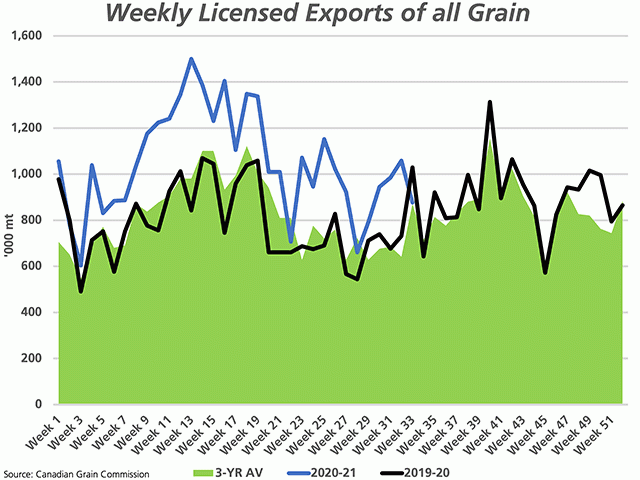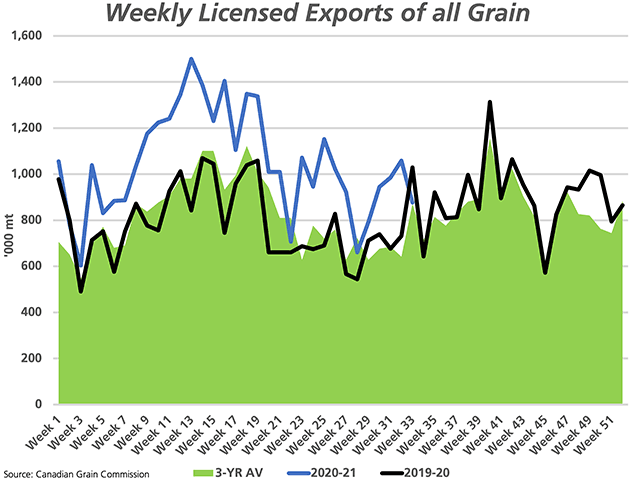Canada Markets
Are Weekly Licensed Exports Signs of Slowing?
The Canadian Grain Commission reported 876,700 metric tons of all grain exported through licensed facilities in week 33, or the week ending March 21. This is the lowest volume shipped in four weeks and compares to the four-week average of 944,825 mt.
Wheat exports for the week were reported at 417,000 mt, the largest volume shipped in six weeks and compares to the four-week average of 305,500 mt. As well, durum exports remain robust, with 144,700 mt shipped during the week, just 325 mt below the four-week average.
Canola exports were reported at 129,100 mt, the smallest volume in five weeks, while the fifth-lowest weekly volume shipped this crop year. At the same time, commercial stocks are reported at 1.6996 million metric tons, up 26% from the three-year average, supporting movement in upcoming weeks.
The attached graphic shows week 33 exports only slightly higher than the three-year average (green shaded area), while falling below the weekly volume shipped for the same week in the 2019-20 crop year (black line) for only the second time this crop year. Week 2 was the last time that the weekly volume shipped this crop year fell below the weekly volume reported for the previous year.
P[L1] D[0x0] M[300x250] OOP[F] ADUNIT[] T[]
The slowing of movement comes at a time when a number of issues, both at home and abroad, may have implications for movement during the balance of the crop year. Some of these include:
1) Canola stocks are tightening and will be rationed during the balance of the crop year. At the same time, two consecutive limit-down closes in May soybean oil futures are likely a warning signal for demand across the entire oilseed and vegetable oil sectors.
2) Containers remain in tight supply on a global basis and there are reports that loaded containers are sitting idle as the focus by shippers remains on getting empty containers returned to Asia for loading.
3) A pending strike at the Port of Montreal could add further challenges for pulse and special crop exports.
4) Reports this week indicated that Black Sea export prices for wheat are down 11% over the week, as demand wanes for the cheapest wheat in the world as attention turns to new-crop supplies.
5) It's difficult to gauge the impact of the Suez Canal blockage on grain movement, although World Grain reports that roughly 55 mmt moves through the canal, while Bloomberg reports USDA statements that close to 7% of grain movement by sea moves through the canal. The backlog will add further pressures on the global container supply.
Cliff Jamieson can be reached at cliff.jamieson@dtn.com
Follow him on Twitter @Cliff Jamieson
(c) Copyright 2021 DTN, LLC. All rights reserved.





Comments
To comment, please Log In or Join our Community .